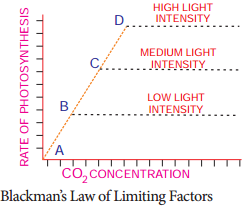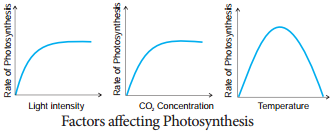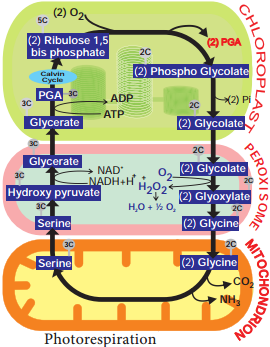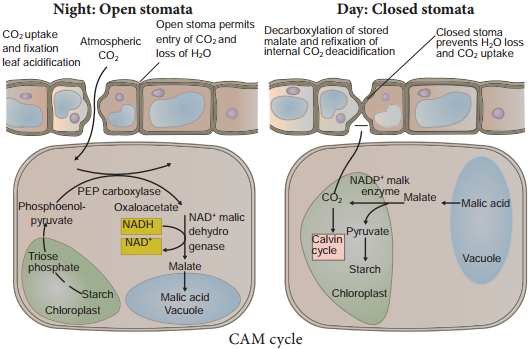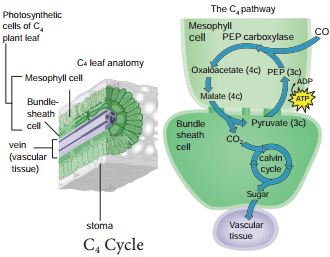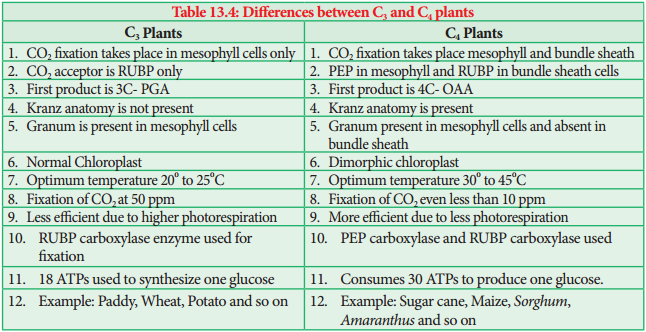Learninsta presents the core concepts of Biology with high-quality research papers and topical review articles.
Photosynthesis in Bacteria
Though we study about bacterial photosynthesis as the last part, bacterial photosynthesis formed first and foremost in evolution. Bacteria does not have specialized structures like chloroplast. It has a simple type of photosynthetic apparatus called chlorosomes and chromatophores (Table 13.6). Van Neil (1930) discovered a bacterium that releases sulphur instead of oxygen during photosynthesis.
|
Photosynthesis in Plants |
Photosynthesis in Bacteria |
| 1. Cyclic and non-cyclic phosphorylation takes place |
1. Only cyclic phosphorylation takes place |
| 2. Photosystem I and II involved | 2. Photosystem I only involved |
| 3. Electron donor is water | 3. Electron donor is H<sub>2</sub>S |
| 4. Oxygen is evolved | 4. Oxygen is not evolved |
| 5. Reaction centres are P700 and P680 | 5. Reaction centre is P<sub>870</sub> |
| 6. Reducing agent is NADPH + H+ | 6. Reducing agent is NADH + H+ |
| 7. PAR is 400 to 700 nm | 7. PAR is above 700 nm |
| 8. Chlorophyll, carotenoid and xanthophyll | 8. Bacterio chlorophyll and bacterio viridin |
| 9. Photosynthetic Apparatus – Chloroplast | 9. It is chlorosomes and chromatophores |
Here, electron donor is hydrogen sulphide (H2S) and only one photosystem is involved (PS I) and the reaction centre is P870. Pigments present in bacteria are bacteriochlorophyll a, b, c, d, e and g and carotenoids. Photosynthetic bacteria are classified into three groups:
1.Green Sulphur Bacteria.
Example: Chlorobacterium and Chlorobium.
2. Purple Sulphur Bacteria.
Example: Thospirillum and Chromatium.
3. Purple Non-Sulphur Bacteria.
Example: Rhodopseudomonas and Rhodospirillum.
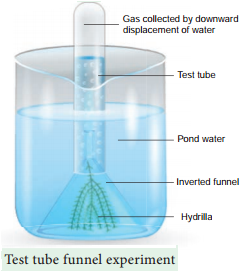
Cyanobacteria contain chlorophyll while other forms of bacteria contain bacteriochlorophyll. Cyanobacteria perform photosynthesis using water as an electron donor in a similar manner to plants. This results in the production of oxygen and is known as oxygenic photosynthesis.
There are several groups of bacteria that undergo anoxygenic photosynthesis: green sulfur bacteria, green and red filamentous anoxygenic phototrophs (FAPs), phototrophic purple bacteria, phototrophic acidobacteria, and phototrophic heliobacteria.
There are several groups of bacteria that undergo anoxygenic photosynthesis: green sulfur bacteria, green and red filamentous anoxygenic phototrophs (FAPs), phototrophic purple bacteria, phototrophic acidobacteria, and phototrophic heliobacteria.
The main purpose of photosynthesis is to convert radiant energy from the sun into chemical energy that can be used for food. Cellular respiration is the process that occurs in the mitochondria of organisms (animals and plants) to break down sugar in the presence of oxygen to release energy in the form of ATP.
Oxygenic photosynthetic bacteria perform photosynthesis in a similar manner to plants. They contain light-harvesting pigments, absorb carbon dioxide, and release oxygen. Cyanobacteria or Cyanophyta are the only forms of oxygenic photosynthetic bacteria known to date.
An example of photosynthesis is how plants convert sugar and energy from water, air and sunlight into energy to grow. The water from the leaves evaporates through the stomata, and filling its place, entering the stomata from the air, is carbon dioxide. Plants need carbon dioxide to make food.
Algae are sometimes considered plants and sometimes considered “protists” (a grab-bag category of generally distantly related organisms that are grouped on the basis of not being animals, plants, fungi, bacteria, or archaeans).
In all phototrophic eukaryotes, photosynthesis takes place inside a chloroplast, an organelle that arose in eukaryotes by endosymbiosis of a photosynthetic bacterium (see Unique Characteristics of Eukaryotic Cells). These chloroplasts are enclosed by a double membrane with inner and outer layers.
The most influential bacteria for life on Earth are found in the soil, sediments and seas. Well known functions of these are to provide nutrients like nitrogen and phosphorus to plants as well as producing growth hormones. By decomposing dead organic matter, they contribute to soil structure and the cycles of nature.
Bacteria are classified into five groups according to their basic shapes: spherical (cocci), rod (bacilli), spiral (spirilla), comma (vibrios) or corkscrew (spirochaetes). They can exist as single cells, in pairs, chains or clusters.
Photosynthesis converts solar energy into chemical energy. Photosynthesis produces carbohydrates. Plants need sunlight, carbon dioxide, water, nutrients, and chlorophyll to complete photosynthesis. Plants use chlorophyll, water, and carbon dioxide to make sugar.
Photosynthesis is the biochemical process in which energy from sunlight is converted by plants, algae, and some bacteria into sugars, which are used by the organism as food. However, there is a least one exception: a little bacterium deep under the Pacific Ocean which manages photosynthesis without sunlight.
Cyanobacteria are oxygenic photosynthetic bacteria. They harvest the sun’s energy, absorb carbon dioxide, and emit oxygen. Like plants and algae, cyanobacteria contain chlorophyll and convert carbon dioxide to sugar through carbon fixation.
According to the diagram of photosynthesis, the process begins with three most important non-living elements: water, soil, and carbon dioxide. Plants begin making their ‘food’, which basically includes large quantities of sugars and carbohydrate, when sunlight falls on their leaves.
The reactants for photosynthesis are light energy, water, carbon dioxide and chlorophyll, while the products are glucose (sugar), oxygen and water.
